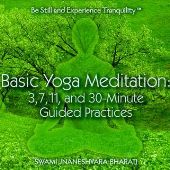|
Home Site Map 7 Skills 4 Steps Short course 50+ Meditations Relaxation Breathing Witnessing Contemplation OM mantra Tantra Yoga Sutras |
|||
|
|
Yoga meditation is the art and
science of systematically Home Yoga Meditation Back Next (To tour 16 aspects
describing Yoga Meditation practice, click Next 16 page summary: In the 16 pages linked in the sentence above, Yoga Meditation is described in practical terms, and simple language. In the science of meditation, the profound is often cloaked behind the simplest words. The explanations in the links should provide a greater sense of the depth of these practices.
Yoga Sutras: Yoga is one of the six schools of Indian philosophy and deals with the practical methods of attaining direct experience of the center of consciousness. Yoga is succinctly described in the Yoga Sutras in 196 pithy phrases or sutras (literally, threads). The gist of the Yoga Sutras is contained in the first few sutras (1.1-1.4). (For book recommendations on the Yoga Sutras, click here) Yoga Meditation Yoga Meditation is the art and science of systematically observing, accepting, understanding, and training each of the levels of our being, such that we may coordinate and integrate those aspects of ourselves, and dwell in the direct experience of the center of consciousness. The links above are to a 16-page description of Yoga Meditation, which explains the process in practical terms, and simple language.
Yoga Meditation is not actually a separate aspect of Yoga, due to the fact that Yoga is meditation. However, the phrase Yoga Meditation is being used here to discriminate between Yoga Meditation and the now popular belief that Yoga is about physical postures. Yoga or Yoga Meditation is a complete process unto itself, only a small, though useful part of which relates to the physical body. (See the article Modern Yoga versus Traditional Yoga) In the Yoga Meditation of the Himalayan tradition, one systematically works with senses, body, breath, the various levels of mind, and then goes beyond, to the center of consciousness. The science of Yoga Meditation as taught by the Himalayan sages is already a whole, complete science that has been torn into smaller pieces over time. Individual parts have sometimes (unfortunately) been cut out from the whole of Yoga Meditation, given separate names, and then taught as unique systems of meditation. The perspective of Yoga Meditation on the SwamiJ.com site is that it is not a pasting together of disparate Yogas, but an already unified whole that we might call Yoga Meditation, or simply Yoga. Yoga Meditation of the Himalayan tradition is holistic in that it not only deals systematically with all levels, but also involves a broad range of practices, including meditation, contemplation, prayer, and mantra, as well as the preparatory practices leading up to these. Yoga Meditation also explores all of the levels of reality and self-construction, including the gross (vaishvanara), subtle (taijasa), causal (prajna), and the absolute (turiya), as reflected in OM Mantra. Finally, Yoga Meditation leads one to the direct experience of the absolute, pure, eternal center of consciousness. The root meaning of Yoga Meditation lies in the meaning of the word Yoga itself, which comes from "yuj" which means "to join," to bring together the aspects of yourself that were never divided in the first place. The Yoga Sutras of Patanjali is a primary source of learning the practices of Yoga Meditation. The finer points of Yoga Meditation are described and taught face-to-face, as it is an oral tradition. Hopefully, the many articles on SwamiJ.com will enhance your understanding and practicing Yoga Meditation. There includes a succinct outline of Beginning, Intermediate and Advanced Yoga Meditation. In the Himalayan tradition, Yoga Meditation is not limited to just the Yoga Sutras, but also includes Vedanta and internal Tantra, while also acknowledging that the practices are also contained in many other sources (See the article, Yoga, Vedanta, Tantra). The teachers of the Himalayan tradition may emphasize or draw on some of these (or other) sources more or less than others, matching the teachings with the student. Yoga Meditation also involves the process of Kundalini Awakening, and this is described in a series of pages on the site. Yoga Meditation is not a religion, although some of the principles are contained within the various religions. There are articles on Mysticism and Religion on the site, which should give a good overview of this perspective of Yoga Meditation. The many articles on Yoga Meditation are linked in the Index pages, which are at the top of this, and other pages. You can easily access those Indexes by clicking on the little mountain icon at the top of any page on the site. Please enjoy your visit to the SwamiJ.com site on Yoga Meditation of the Himalayan Tradition, and do come back often to visit.
------- This site is devoted to
presenting the ancient Self-Realization path of
the Tradition of the Himalayan masters in simple, understandable and
beneficial ways, while not compromising quality or depth. The goal of
our sadhana or practices is the highest
Joy that comes from the Realization in direct experience of the
center of consciousness, the Self, the Atman or Purusha, which is
one and the same with the Absolute Reality.
This Self-Realization comes through Yoga meditation of the Yoga
Sutras, the contemplative insight of Advaita Vedanta, and the
intense devotion of Samaya Sri Vidya Tantra, the three of which
complement one another like fingers on a hand.
We employ the classical approaches of Raja, Jnana, Karma, and Bhakti
Yoga, as well as Hatha, Kriya, Kundalini, Laya, Mantra, Nada, Siddha,
and Tantra Yoga. Meditation, contemplation, mantra and prayer
finally converge into a unified force directed towards the final
stage, piercing the pearl of wisdom called bindu, leading to the
Absolute.
|
|
|



